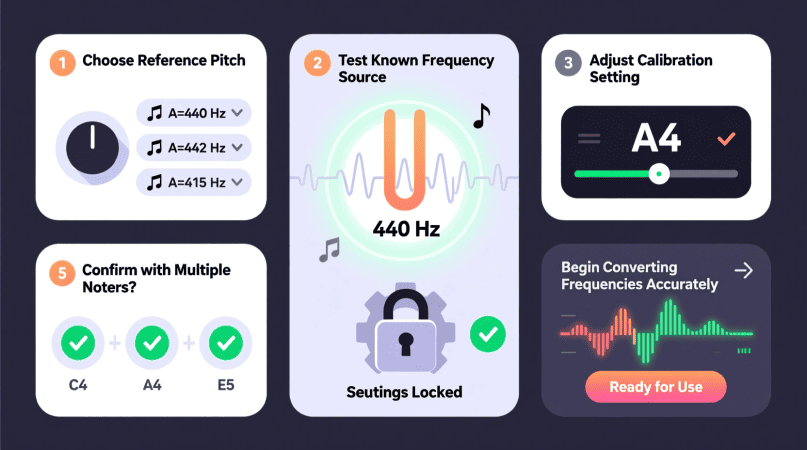
Converting frequency (Hz) to musical notes is only truly useful if your readings are accurate and calibrated for the right tuning standard. Whether you’re analyzing vocals, tuning instruments, or preparing orchestral music, understanding A440 vs A442 and calibration settings is key to precision.
This guide explains how accuracy works in frequency → note conversion, how to calibrate your tool, and best practices for consistent results.
Why Calibration Matters in Music
Standard concert pitch sets A4 = 440 Hz, but:
- Some orchestras use A4 = 442 Hz for a brighter tone.
- Baroque ensembles may use A4 = 415 Hz for historical accuracy.
- Electronic instruments may drift if not calibrated correctly.
If your converter or pitch detector isn’t aligned to the right reference, all notes will read sharp or flat by the same margin.
How Frequency → Note Conversion Accuracy Works
- Input Frequency: Measured in Hertz (Hz).
- Mathematical Formula: Note Number=69+12×log2(f440)\text{Note Number} = 69 + 12 \times \log_2\left(\frac{f}{440}\right) where ff = frequency in Hz.
- Tuning Reference: Adjust formula for A4 = 442 Hz or other values.
- Result: Musical note name + ±cents deviation from the note center.
Calibration Settings in the Converter
On the Frequency → Note Converter:
- Default: A4 = 440 Hz (concert pitch)
- Custom Calibration: Change to 442 Hz or other references for orchestral or regional tuning standards.
- Accuracy: ±1 cent under optimal conditions (quiet environment, good mic).
For pitch detection in recorded files, use the Audio-File Pitch Detector.
Best Practices for Accurate Results
| Factor | Recommendation |
|---|---|
| Quiet Environment | Avoid background noise & echo |
| Mic Placement | 20–30 cm from source, stable input |
| Consistent Calibration | Always use the same tuning reference |
| File Quality | WAV > MP3 for recording analysis |
For live singing calibration tips, see Voice Pitch Analyzer.
A440 vs A442: Which Should You Use?
- A440 (440 Hz):
- Standard for most modern Western music
- Used in pianos, guitars, school music programs
- A442 (442 Hz):
- Preferred by some European orchestras
- Slightly brighter tone, better for certain ensembles
Choose based on ensemble requirements or personal preference.
FAQs
1. Does calibration affect ±cents readings?
Yes, all note calculations shift when you change A4 tuning references.
2. Should choirs use A440 or A442?
Most school and community choirs use A440; professional orchestras may prefer A442.
3. How often should instruments be recalibrated?
Check before every performance or recording session.
Pitch Detector is a project by Ornella, blending audio engineering and web technology to deliver precise, real-time pitch detection through your browser. Designed for musicians, producers, and learners who want fast, accurate tuning without installing any software.
